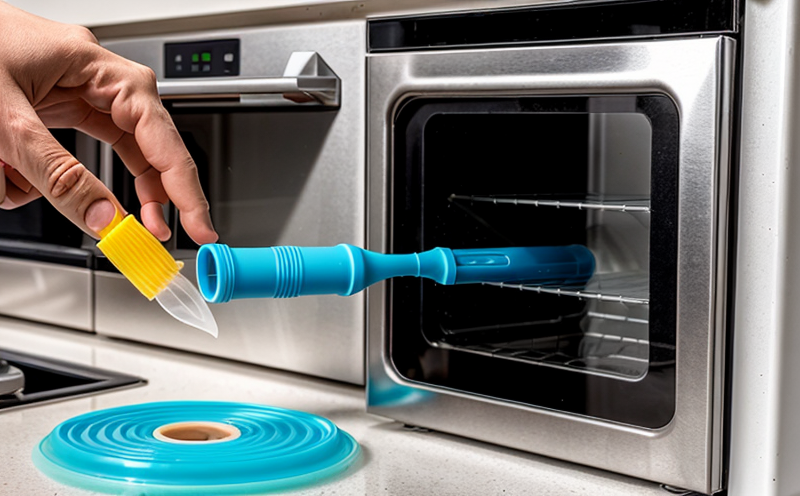ASTM D1525 Vicat Softening Point Testing of Household Plastics
The Vicat softening point is a fundamental test method used to determine the thermal properties of plastics. ASTM D1525 specifies the procedure for measuring the Vicat softening temperature of household plastics, which are defined as materials used in products within the home such as containers, utensils, and furniture components. This test provides critical information about how these plastics behave under heat stress.
The Vicat softening point is determined by subjecting a standard cylindrical specimen to gradually increasing load until it causes a specific deflection on a metal needle. The temperature at which this occurs is recorded as the Vicat softening point in degrees Celsius (°C). This test method is essential for quality assurance and compliance, ensuring that household plastics meet the necessary standards for durability and safety.
For household plastics, the Vicat softening point can influence various product characteristics. For instance, it affects the plastic's ability to maintain structural integrity at elevated temperatures encountered during manufacturing or use in hot environments. This test is particularly important for materials such as polyethylene (PE), polypropylene (PP), and polystyrene (PS) used in a wide range of everyday items.
The ASTM D1525 method provides detailed instructions on specimen preparation, testing apparatus, and the procedure itself. Specimens must be prepared according to precise dimensions and tolerances outlined in the standard. The test apparatus includes a Vicat softening point tester which consists of a heated furnace chamber and a needle that is lowered onto the specimen until it causes a deflection of 1 mm.
The test results are critical for ensuring product safety and compliance with regulations such as ISO 9001 and ASTM F825. Compliance ensures that products meet specific performance requirements, enhancing consumer confidence in brand reliability. For quality managers and R&D engineers, this test provides data essential for optimizing material selection and process control.
The Vicat softening point is also a key factor in the design of household plastics where long-term durability under heat stress is critical. The test helps identify suitable materials that can withstand the environmental conditions they are likely to encounter during use. This ensures that products like cooking utensils or storage containers remain functional and safe over their expected lifespan.
In summary, ASTM D1525 Vicat softening point testing of household plastics offers valuable insights into material performance under heat stress. It is a crucial step in ensuring product safety and quality, which is essential for compliance with industry standards and consumer expectations. This test plays an important role in the development and manufacturing processes, contributing to the overall reliability and longevity of household products.
Benefits
Conducting ASTM D1525 Vicat softening point testing offers several significant benefits for manufacturers and quality assurance teams:
Enhanced Product Reliability: By identifying the temperature at which a plastic specimen begins to soften, this test ensures that household products maintain their structural integrity under heat stress.
Improved Compliance: Ensures adherence to international standards such as ASTM D1525 and ISO 9001, thereby facilitating compliance with regulatory requirements.
Optimized Material Selection: Provides data that aids in selecting the most appropriate materials for specific applications, leading to better product design and performance.
Informed Product Development: Offers insights into material behavior under heat stress during development stages, helping engineers make informed decisions about material properties.
Increased Consumer Confidence: By ensuring that products are safe and reliable, this test builds trust with consumers, enhancing brand reputation.
In conclusion, ASTM D1525 Vicat softening point testing is a vital tool for quality assurance teams. It not only ensures product safety but also contributes to the overall success of manufacturing processes by providing critical data that can be used throughout various stages of product development and production.
Why Choose This Test
The ASTM D1525 Vicat softening point test is chosen for several reasons. Firstly, it offers a precise method to measure the thermal properties of household plastics, providing reliable data that can be used in quality control processes. Compliance with this standard ensures that products meet rigorous safety and performance criteria.
Secondly, the test is particularly useful for R&D engineers who need accurate information on material behavior under heat stress conditions. This helps them make informed decisions about new product designs and modifications to existing ones. By understanding how different plastics behave at various temperatures, they can optimize materials for specific applications.
Quality managers also benefit from this test as it allows them to monitor the quality of incoming raw materials and outgoing products continuously. It provides consistent data that helps maintain high standards throughout the production process. This is crucial for maintaining consistency in product performance across batches.
In addition, compliance officers find value in this testing method because it ensures adherence to relevant regulations and industry best practices. By conducting these tests regularly, they can ensure that all products meet required safety levels and quality standards. This helps avoid potential legal issues and negative publicity associated with non-compliance.
The Vicat softening point test is also beneficial for procurement departments as it aids in selecting suppliers who provide reliable materials consistent with specified performance criteria. By using this test during supplier evaluation, companies can ensure that they are working with reputable partners delivering high-quality raw materials.
In summary, the ASTM D1525 Vicat softening point test is essential for maintaining product safety and quality while ensuring compliance with relevant standards. Its precision makes it an indispensable tool across various departments within manufacturing organizations.





